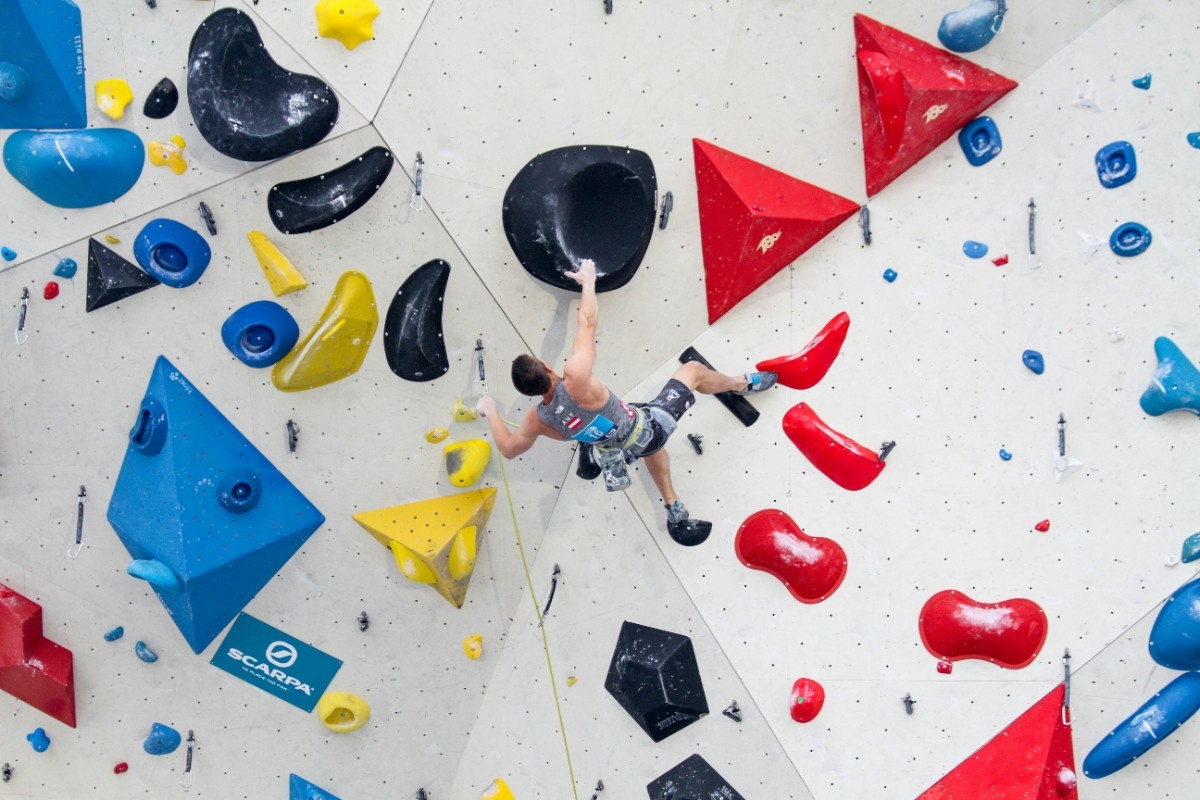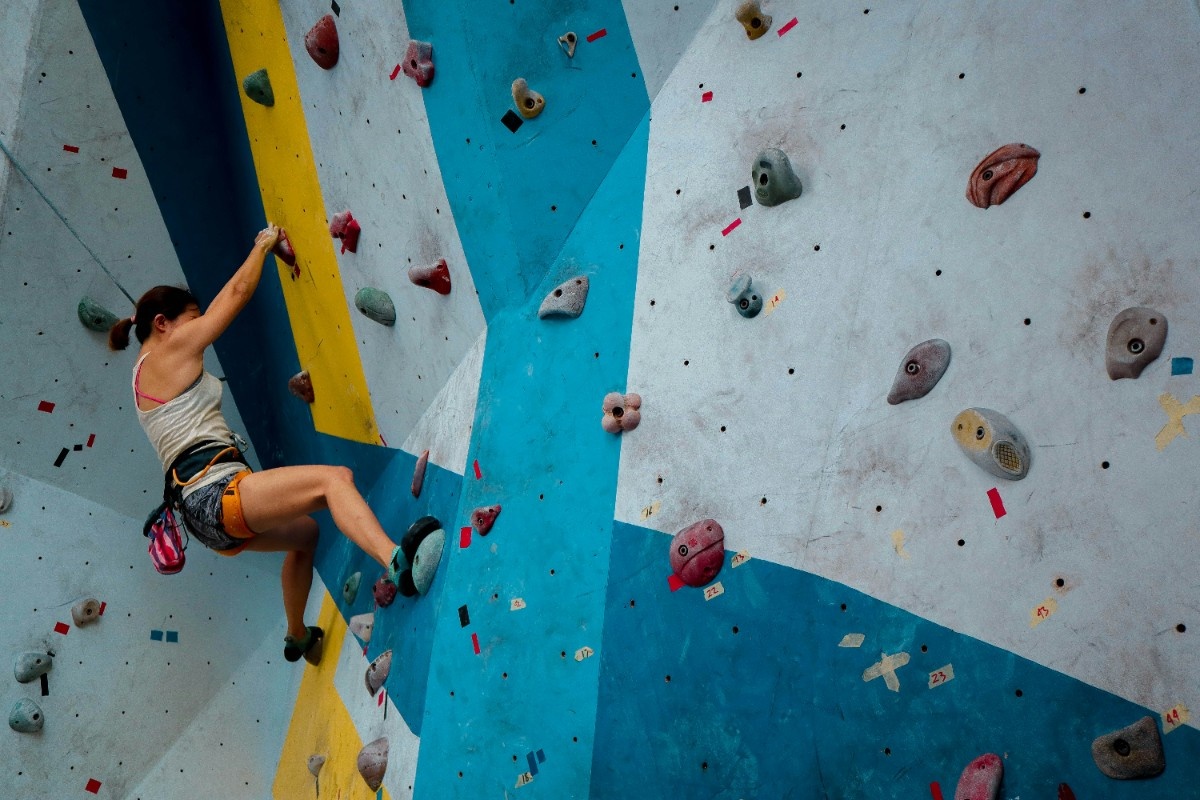HOW TO GET INTO INDOOR CLIMBING

Indoor climbing is an easily accessible activity which is fun and highly beneficial for experienced mountaineers and first-time climbers alike (whether you’re planning on eventually rock climbing in the great outdoors or not). Gareth Davidson from Snow+Rock tells us what to bring and what to expect from our first session on the indoor wall.
What are the Benefits of Indoor Climbing?
Indoor climbing offers a wide range of benefits, making it a fantastic activity for beginners and experienced climbers alike. Here’s why you should consider giving it a try:
Physical and Mental Benefits
- Full-body workout: Climbing engages muscles all over your body, especially your core, arms, and legs.
- Finger strength: Indoor holds are generally easier on your hands, allowing you to build finger strength and condition your body gradually.
- Mental challenge: Solving climbing routes (also called “problems”) is like a puzzle for your mind, helping improve focus and problem-solving skills.
Social and Practical Advantages
- Great social activity: Climbing gyms are friendly, supportive environments where you can meet new people and climb with friends.
- Weather-proof: No need to worry about rain or cold—indoor climbing is available year-round, whatever the weather.
Variety for All Levels
Most climbing centres cater to a range of climbing styles, so you can find something that suits your interests and experience level:
- Top roping
- Lead climbing
- Bouldering
- Traversing
- Ice climbing (in some specialised gyms)
Tips for Getting Started
Go in with an open mind and be patient—climbing involves a lot of trial and error, but you’ll improve with practice. To save energy and climb smarter, take a moment to plan out your route before you start.
This structure helps readers quickly understand the benefits and get practical advice as they start their indoor climbing journey!

You can also gain instruction from the wall or from experienced climbers. The routes for indoor walls are created by experienced climbers (or ‘route setters’) simulating movements they’ve found when climbing outside. This helps beginners develop movement patterns in climbing, while it also benefits experienced climbers who are training for routes outdoors.
What Do I Need for My First Session?
Getting ready for your first indoor climbing session is simple and stress-free. Here’s what you should know before you head to the gym:
What to Wear
- Choose clothing that allows you to move freely and stay comfortable while climbing:
- Shorts, tracksuit bottoms, or leggings
- A comfortable, loose-fitting t-shirt or athletic top
- Avoid overly baggy clothes that could get caught on holds or equipment
Essential Gear
Most climbing centres provide the basic gear you’ll need for your first session:
- Climbing shoes: Usually available to hire at the gym
- Harness: Also available for rent
- Belay device and carabiners: Often provided or available for hire if you’re rope climbing
Note: The only item you may need to bring or purchase is a chalk bag, as many gyms do not provide these. Chalk helps keep your hands dry and improves your grip while climbing.
What Climbing Shoes Do I Need?
Before taking the plunge, hire the shoes. If you do want to buy some, go for basic entry-level shoes that fit. Climbing shop staff will be able to offer you advice as the sizing is very different from buying the normal shoes you walk around in every day.
Rory McCrea, from Snow+Rock Covent Garden, adds: “Be prepared for some early discomfort. Climbing shoes are supposed to be tight, but not painful. Don’t get too hung-up on shoes marketed as ‘indoor shoes’ or what you might have seen high-level climbers wearing – everyone’s feet are different. Try a couple of pairs on in-store and see what work best for you!”
What is the Best Way to Warm Up and Warm Down?
Mobilise the joints and raise your body temperature. Do small rotational movements for your joints – ankles, knees, hips, spine, shoulders, elbows, wrists and neck. You can then either run on the spot or skip to raise your body temperature. After, choose easy routes to warm-up on before trying anything more demanding (you can even use the traverse wall for this). The warm-down with a few easy climbs and dedicate some time to stretching your muscles to help aid better recovery.
What Climbing Centres Would You Recommend in the UK?
The UK is home to some of the best indoor climbing centres, each offering unique features, vibrant communities, and top-notch facilities for climbers of all abilities.
Edinburgh International Climbing Arena: Ratho
Located just outside Edinburgh, this massive centre is built into quarry walls, offering an impressive array of climbing options, a bouldering room, aerial assault course, and gym. Its scale, accessibility, and variety make it a must-visit for climbers seeking adventure and challenge in Scotland.
Bethwall Green Climbing Centre
Situated in East London, Bethwall Green stands out for its welcoming atmosphere, spacious layout, and wide range of routes. It's especially praised for inclusivity, making it a great spot for climbers of all backgrounds and abilities.
Redpoint Birmingham Climbing Centre
Redpoint Birmingham offers a comprehensive climbing experience with walls for all skill levels, courses, a shop, and a vegetarian café. Its friendly environment and variety of climbing styles make it a top choice in the Midlands.
As one of the largest bouldering gyms in the UK, Depot Climbing Manchester excels with its vast space, frequent route resets, and inclusive community. The centre also features dedicated training areas and a café, making it ideal for both serious climbers and social visits.
Located near Bracknell, Oakwood Climbing Centre is renowned for its accessibility, extensive climbing facilities, and welcoming vibe. It's a solid choice for families and climbers looking for a supportive environment.
This Manchester-based gym is popular for its diverse bouldering terrain, dedicated kids’ area, and relaxed café. It’s a top pick for families and those seeking a friendly, community-focused climbing experience.
The Climbing Hangar in London is dedicated to bouldering and offers a wide range of routes across three levels. Its inclusive, LGBTQ+ friendly environment and variety of courses make it a standout in the capital.
Indoor Climbing FAQs
For bouldering, you only need climbing shoes, chalk, and comfortable clothing. For roped climbing, add a harness, belay device, and carabiner. Most climbing gyms offer rental gear, so you can try the sport without a big upfront investment.
Yes, indoor climbing is beginner-friendly. Most gyms offer induction sessions, safety briefings, and beginner routes. Staff can guide you on basic techniques and equipment, making it easy to start even with no prior experience.
No prior fitness level is required. Climbing builds strength, balance, and flexibility over time. Start with easier routes and progress at your own pace. Warming up and stretching before climbing helps prevent injury and improves performance.
Wear comfortable, stretchy clothing that allows free movement. Avoid overly baggy clothes that could catch on holds or equipment. Climbing-specific apparel isn’t necessary for beginners—any athletic wear works well.
Always follow gym rules, use proper equipment, and double-check knots and harnesses before climbing. Listen to staff instructions and never climb above your ability level. For roped climbing, learn correct belay techniques and always climb with a partner.
Most climbing gyms welcome children, often offering special classes or family sessions. Age and supervision requirements vary, so check with your local gym for details.
Related Articles

Let us know you agree to cookies
We use marketing, analytical and functional cookies as well as similar technologies to give you the best experience. Third parties, including social media platforms, often place tracking cookies on our site to show you personalised adverts outside of our website.
We store your cookie preferences for two years and you can edit your preferences via ‘manage cookies’ or through the cookie policy at the bottom of every page. For more information, please see our cookie policy.



